-
Posts
782 -
Joined
-
Last visited
-
Days Won
15
Content Type
Profiles
Forums
Calendar
Gallery
Articles
420 Directory
Classifieds
Posts posted by TheUltimateNoob
-
-
Morning!... Sorry I was mistaken... With my dark cycles during the day, my temps rarely go below 20C.Morning!15 c is too low. Do you have a reliable thermometer?
15C was air temp on my external thermometer measuring the air in the garage.
With lights on, the temps in the tent are around 24-28C.
Measurements are across 2 digital thermometers, I've checked them against like 5 or 8 other digital ones I have (the little ones with hygrometers for jars)
Some of them vary by about 1-2C. They're decently accurate.
Sent from my POCOPHONE F1 using Tapatalk
-
Lights are off right now... I run the dark cycle during the day to keep temps a bit stable.What are the variables in your environment? Do you use a heater when the lights are off? We just had our first really cold snap and your issues could be related to root temperature.
Sent from my POCOPHONE F1 using Tapatalk
-
No I don't use one... I don't think I see anything less than 15°C air temp inside the tent, max gets to around 28 with humidity between 50-70%... Not sure about the roots, will have to stick a thermometer in the soil for a whileWhat are the variables in your environment? Do you use a heater when the lights are off? We just had our first really cold snap and your issues could be related to root temperature.Sent from my POCOPHONE F1 using Tapatalk
-
 1
1
-
-
Yeah my suspicion is that the yellowing is my issue here, and the droopy leaves is just her having not recovered from the abuse yet... The lockout is just making it look worseI can't comment on the solution, coco is out of my realm but those plants do definitely look Manganese deficient. The droopiness might not be related though, just to keep in mind. Might even be a lockout if you're experiencing deficiencies close to feeding. If I were experiencing this I'd probably opt for a flush and a fresh low dose feed and work my way up in ppm. I'd also just stick to ph of 5.8 when experiencing a problem rather than making fluctuations while the plant is unhappy.
Just my but I'm sure a coco guru will give a better definitive answer.
but I'm sure a coco guru will give a better definitive answer.
Sent from my POCOPHONE F1 using Tapatalk
-
 1
1
-
-
Yeah, coco and hydro are the same in that sense.
The coco is simply a medium in which the water / nute mixture is held. Coco does not contain any nutrients at all, unlike with soil.
@TheUltimateNoob so @CreX and I were talking and you're using Freedom Farms Formula 1, which isn't pure coco / perlite. It contains some amendments, if you're feeding according to the coco / hydro guide on the bottle this may be causing issues as the amendments are also providing nutes.
Ingredients: Coco Coir, Worm Castings, Perlite (30%), Volcanic Rock Dust, Bone meal, Gypsum, Fermented probiotic bran.
That is the Formula 1 mix. So I'd certainly lower the nutes you're giving, perhaps even follow the soil chart for the GHE nutes instead - I have not looked at what those dosages are like though.
Yeah bro I used to feed according to this soil pH absorption chart I've attached for a while (because the medium is pH balanced at 6.5) before I got the suggestion to follow Hydro pH levels.
I didn't have any issues before, even at high ppms - I've hit 1000 by accident for a week once - I think changing the pH kinda f*d me over just a little bit, but this looks more like a lockout issue now after reading through everything... The feedings have been around pH 6 for over a week... This may have given the opportunity for P to lockout Mn according to the hydro pH chart... Wouldn't make sense with the soil chart unless the P just caused a lockout due to toxicity.
They're due for a drink tomorrow so I think I'll flush with 5L of pH'd water each, measure runoff pH and ppms, then flush again if necessary and give them a low dose of Micro... (was supposed to be water only)
Sent from my POCOPHONE F1 using Tapatalk
-
 1
1
-
-
Thanks bro. I'm also leaning towards Mn deficiency... The pH wouldn't have allowed for uptake efficiently.I can't comment on the solution, coco is out of my realm but those plants do definitely look Manganese deficient. The droopiness might not be related though, just to keep in mind. Might even be a lockout if you're experiencing deficiencies close to feeding. If I were experiencing this I'd probably opt for a flush and a fresh low dose feed and work my way up in ppm. I'd also just stick to ph of 5.8 when experiencing a problem rather than making fluctuations while the plant is unhappy.
Just my but I'm sure a coco guru will give a better definitive answer.
but I'm sure a coco guru will give a better definitive answer.
Sent from my POCOPHONE F1 using Tapatalk
-
 1
1
-
-
Greetings Fam, hope you guys can help me.
I can't quite figure this one out... I was thinking K or P excess? Not too sure though. I doubt it's a deficiency because I fed at 800ppm on the 27th - which is whats confusing me.
I started the flower ratio with GH Tripack just before first week of 12/12 and that week is just about over.
I shifted my pH range from 6.2-6.7 to 5.5-6.1 after receiving a suggestion from@PsyCLown if I'm not mistaken due to my medium being primarily Coco (Freedom Farms Formula 1).
After doing some searching and going back into my nutrient logs, I feel like it's a Mn (Manganese) deficiency due to incorrect pH (ph was too high at just above 6) and they were fed on the 24th not long after lights on and halfway through the light cycle in the early hours of the 27th... The 2 feedings before that were at a slightly lower pH but they still weren't low enough to compensate. I haven't went below 5.6 for about 2 weeks.
The yellow is coming in from the inside out, with the newer growth being the worst off. Made me think maybe N deficiency but it doesn't look typical and a N deficiency at this ppm level is unlikely, although not impossible.
The Inzane bounced back well, but the Black Fire is just looking sad. Yet they receive the same treatment.
Maybe the Black Fire is so sad because she hasn't bounced back from the lollipop and the pH issue is making it worse, but I'm really lost.
I want to give them a feed tomorrow with Flora Micro only added to about 300ppm at pH 5.3 (it was supposed to be water only but I want to boost Mn uptake).
I'll pH my 4 feedings at 5.3; 5.6; 5.9 & 6.2 respectively afterwards, followed by water at pH 5.3 for the plain watering and then repeat the cycle. I'll try to get those numbers as close as I can to try to balance everything out.
I added some supporting evidence as to how I got to my conclusion as well as a few shots of the trees. If anyone could let me know if I'm on the right track with fixing the issue, I'd really appreciate it, also any advice pertaining to this specifically from experienced growers would help a lot. This has me stumped.
Any thoughts?
Apologies if the images are bad quality, had to use Tapatalk to upload them.






Sent from my POCOPHONE F1 using Tapatalk
-
Honestly I'd go with import and DIY unless a local company provides a decent enough warranty.Sure. Can I buy KingBright products from someone directly in SA or do I have to import and DIY?
This isn't a stab at Master's products or company, don't get me wrong. I'd rather get more boards and bits for the same price with a shorter warranty, so I can make more lights if necessary.
If you're importing, spares are gonna be cheap anyway. I would get a board or 2 extra to keep aside just in case.
If you're ordering it locally, there's nothing bad I can say really. You'll have a nice product with a company to go to if it starts giving you shit... But no spares or extras.
Sent from my POCOPHONE F1 using Tapatalk
-
Thank you for this... I've fixed themPics dont work
Sent from my POCOPHONE F1 using Tapatalk
-
9 hours ago, CreX said:
Yea, no offense Totemic, but you can get 2x 150w 6000k led flood lights that put out crazy lumens and are just under 400 a pop.
I've always thought about doing this... Got a link to a journal or something I could read through with a grow using these?
-
 1
1
-
-
Greetings everyone. Back with another update;
I fed them about half way into their light cycle then proceeded to lollipop and defoliate them. This time it was some proper abuse, lol.
I took 4 clones off each tree and stuck them under a humidity dome in my incomplete veg box. Let's see what happens.
Here are the before and after shots, as well as some of the clones.
-
 2
2
-
-
Hopefully Tapatalk leaves this legible at least... But here's the 600w modelI read about a guy online who did the comparisson test between the 2 QBs, with red & without. Apparently there was no noticeable difference between the 2 plants grown in the same conditions. Don't have the link, sorry.
I've been shopping around for QBs and the best I can find so far is R16k for a 600W LED QB with LM301h 3500k diodes + 660nm red from epistar. Still feels overpriced but is that the going rate these days, more or less?
Sent from my POCOPHONE F1 using Tapatalk
-
Thanks for this ^I read about a guy online who did the comparisson test between the 2 QBs, with red & without. Apparently there was no noticeable difference between the 2 plants grown in the same conditions. Don't have the link, sorry.I've been shopping around for QBs and the best I can find so far is R16k for a 600W LED QB with LM301h 3500k diodes + 660nm red from epistar. Still feels overpriced but is that the going rate these days, more or less?
Kingbright has them dirt cheap... If you're willing to sacrifice a little bit of your piece of mind. Lol. R16K is bloody madness... I'm matching up a 320w kit with 4 boards for my DIY rig... The entire thing with shipping is coming to like 6.5k
Sent from my POCOPHONE F1 using Tapatalk
-
No they won't... What your budget like? Drop me a message, maybe I can help. Also from SAhi guys im new to growing gona start with 6 clones , just wanted to know if the bulbs im getting would work fine for growing please assist
wanting to use these https://www.takealot.com/exo-terra-sun-glo-tight-beam-basking-spot-lamp-150w/PLID41124439
Sent from my POCOPHONE F1 using Tapatalk
-
I get everything you're saying. And yeah I guess that would be the only way to actually check if the red spike makes a difference.
If you really want to do a side by side comparison, purchase one of each type of QB (a plain 3000k and a 3000k with 660nm diodes), take a cutting of a plant and stick a cutting into each tent (one tent with one type of QB and the other tent with the QB with extra 660nm).
Set the power to the same and hook both plants up to the same res with an auto watering system and then compare at the end of the grow and see for yourself how much of a difference, if any, is noticed. I have not done this test myself, however I am quite certain the difference will be minimal to none.
I could be wrong though, as mentioned. I have some QB's with extra 660nm Samsung diodes and then I have some without the 660nm diodes.
I doubt I would purchase QB's with the diodes again unless the price difference is practically non-existent or there are stock issues. If it gives you peace of mind though, then go for it. I do not recommend you pay significantly more for QB's with 660nm diodes though.
These are the red dioes on my QB's: https://www.samsung.com/led/lighting/high-power-leds/3535-leds/lh351h-deep-red/
Sent from my POCOPHONE F1 using Tapatalk
-
1 minute ago, Bakstein420 said:
@TheUltimateNoob not my thread bud

shite... meant @BigBudD , thanks, and apologies. lol
-
 1
1
-
-
ah okay, thanks for the info, I forgot that the 301h comes in red... with what I have planned, the fixture will have 3 or 4 boards with 16 red diodes on each board. It may be enough to create a small spike.
I did read up a bit on the wavelength some time ago and 660 is optimal for flower so they say. I guess that's why I've been so set on it.
I want to spread out PAR more evenly and may get a high power driver so I'm willing to trade off some intensity for the red spike... Honestly I would't know for sure if it would help that much, but I'll do some more reading and make a decision before I pull the trigger.
Any idea about the shipping?
and @Bakstein420, I'm so sorry for hijacking your thread bro. lol
-
Great idea to regulate output, that is definately an easy Diy. You could even use an 'air regulator' for fishtanks.
Key things to remember
1. Dissolve all sugar, use a stove top if needed. I normally just boil the kettle, +- 1.7L, dissolve my 500g - 600g brown sugar.
2. Ensure sufficient oxygen. Yeast needs oxygen and sugar to create Co2. Using a 5L bottle, shake up the remaining 3.3L or use an airstone and pump to add O2.
3. Add dissolved sugar mixture to cold water. Once sugar has been added, you can once again give it a good shake, ensure proper mixing whilst adding O2 by means of shaking
4. Temperature, you want your water temp to be around room temp, if the water is too hot, it will kill your yeast, same goes for cold water. When water is right temp, add your yeast. 5g per 5L, but using those 7g anchor sticks, will work just fine.
5. Do not shake the bottle after adding yeast, you can after 15mins,turn the bottle a few times to mix, but don't shake.
6. Water trap. It is quite important to make sure no O2 can get back into your mix. A pinhole or 2 in the lid of a cooldrink bottle will also works.
Good luck and use that brewers yeast to make some cider :). Brewers yeast is hard to come by at the moment.
Sent from my CLT-L29 using Tapatalk
Thank you so much for all of this, it will definitely help me. I didn't get a chance to get the yeast today so I'll get going on it tomorrow. I might be able to get the valve as well.
I'm a bit confused by what you meant with no. 6
I did follow your steps though, I have a chemistry background and know a few microbiologists so I had a base knowledge on the process, my ratios were just way off as I didn't know yeast was this active.
I won't lie, it's a fun project.
I want to regulate it such that there's always a slight bit of positive pressure inside the generator and collector bottles, and ultimately get the solution to continue producing CO2 for a week or 2.
Sent from my POCOPHONE F1 using Tapatalk
-
@PsyCLown the lm301b & lm301h are the 3000k diodes on your boards - they do come in different K - b is the older version and h is the newer "horticultural" led.
The red diodes can be either CREE or Epistar 660nm diodes. Depending where you got the boards from.
The UVA diodes are normally LG.
Sent from my POCOPHONE F1 using Tapatalk -
@TheUltimateNoob so I have some 3000K normal QB288's with LM301B diodes then I have some which are 3000K with LM301B diodes and some red diodes which I think are LM351H diodes.
Honestly I do not notice any difference between the two, the amount of red in 3000k I feel is sufficient and I do not see much of a need for the extra red diodes.
Also after watching a MiGro video about UV light, I feel that UV LED's are a waste and more marketing than anything else.
EDIT: I would also not purchase from that Onlinegrowshop, this is based on what another member (cannot remember who) had posted with regards to what they use as heatsinks and the type of drivers they use etc.
Yeah I've read up a bit on the diodes and Samsung themselves say they're the same. The graphs for CRI spectrums were labelled incorrectly and there was a whole lot of speculation online with people saying the H diodes are better.
I wanted to go for the boards with the added reds because I feel the 660nm diodes will be advantageous as I want to have it in a dedicated flower tent.
I've watched that video, and I may opt for boards without UVA diodes as I want to add 2 x 8w supplemental UVB/C cfl tubes... Not sure where to get them though.
EDIT: UVA/B
UVA is less effective against PM and I don't think a few diodes will be enough to cover the tent either, it just may affect the trichomes that are pretty close to them due to direct exposure.
I was planning to order all the bits from Kingbright
..
Off topic a slight bit, does anyone know if we can receive deliveries from Alibaba right now?
Sent from my POCOPHONE F1 using Tapatalk
-
Loving the entries this month... The small characters are killing me, lol.
Sent from my POCOPHONE F1 using Tapatalk-
 1
1
-
 1
1
-
 1
1
-
-
Lmao, I was just coming on here to say I may have made a mistake... But I didn't know there were different yeasts so I'll head out tomorrow and get the bakers one.I could be wrong, but Brewers / brewing yeast may not be the best option here, although it will certainly cause no harm.
When brewers yeast consumes sugars, it creates co2 and alcohol, whereas bakers yeast will focus on co2, with alcohol as a side effect. I've found that 1g of yeast per 100g sugar and 1L water seems to be a pretty fool proof recipe with plenty bubbling...
Sent from my CLT-L29 using Tapatalk
Anyway, I've added waaaaaaay too much yeast in this bottle, it stopped bubbling in about 24 hrs.
I've transferred the contents to a 5L bottle and added 2 more cups of sugar to keep it going as well as another 2L of water.
I was also thinking of having a bottle between the generator and detector to serve as a CO2 collection vessel... I can then add a small valve to somewhat regulate the flow of CO2, hopefully to make the entire thing a bit more efficient.
Sent from my POCOPHONE F1 using Tapatalk
-
 2
2
-
-
Haha, you're 10 bucks out bro!... I haven't started my alcohol brew yet, lmao. I was thinking about it last night.Nice man, looks like a pretty neat job too!!
Let us know how it goes.
Iv never played with co2 but am super keen to try some things... I'll be trying the sealed room vibe so it's on ice atm so I can get everything I need lol.
For now, I know that it must be dark dark during night cycle, and that plants absorb co2 during light cycle.
So I'm in the fortunate position to be able to keep my flowering tent open the entire 12h to allow for a much more stable co2 concentration throughout my tend during lights on... Sure it's still only 400ppm... But it's better than a poor ventilation system.
Kuddos on the co2 generator lol... Ten bucks says you have an alcohol brew on the way in your cupboards too?
Sent from my POCOPHONE F1 using Tapatalk
-
 1
1
-
-
Well, it's been more than a few hours but;
Greetings everyone! Lol
Update time.
The tent is looking awesome right now.
I changed the timer to 12/12 and flipped the bloom switch on as well. They're due for a feeding when the light comes on later.
They're also in for a major defoliation in a few days... Let's hope it isn't too much for them to handle.
So I took on a small project that took me about 45 chilled minutes to get done.
A Small DIY CO2 generator.
I know some of the advantages and disadvantages of running CO2 in a tent and how to properly use it, but I figured it couldn't hurt even though I have a vented setup. I'm not gonna seal up my tent, try to control climate and all that stuff, it's just something new to do and maintain. Please don't hate, lol.
To make the generetor;
- I simply rinsed out a 2L bottle, filled it a bit over the label with tap water (my tap water is pretty clean @67ppm). I know distilled water is better to use but I wasn't up to waiting for some to get delivered or setting up a quick distillation apparatus. The cost is minimal this way.
- I added almost a cup full of brown sugar and shook the bottle until all the sugar was dissolved.
- I made a hole in 1 bottle cap for the sugar/yeast mixture and hot glued a pipe in place for the CO2 to travel through as well as to serve as a detector in another bottle.
- I added a 20g sachet of dry, high foam superbrew yeast to the bottle and shook it up a bit (closed with a normal cap) first to mix it up. I then screwed the cap with the single pipe onto this bottle and left it aside to allowe some time for the mixture to start reacting.
- I made 2 holes in the cap for the "detector" bottle, 1 for the pipe from the first bottle submerged in water and the 2nd to channel the CO2 to the circulation fan with both pipes sealed onto the cap with hot glue. The pipe is submerged so it can develop bubbles as CO2 is being formed. This is so I can monitor how active the mixture is.
- I tied a small hand towel over the yeast mixture to shield it from my grow light and placed everything in the tent.
I'll maintain this yeast solution by emptying out 70-80% of the solution out, filling it up with fresh water and adding another cup of sugar.
This will be done every week or so, I'll judge by how many bubbles per/s can be viewed at the detector. The process creates byproducts that will make the solution toxic to the yeast if left unattended for more than a week or 2.
Here's a short video on the setup;
https://www.instagram.com/p/CAgmEdQh96P/?igshid=5rkucicrj7bt
I'll put up a few pictures of it also, in case the link doesn't work for you.
I've included a few shots of the girls as well.
Enjoy.
-
 2
2
-


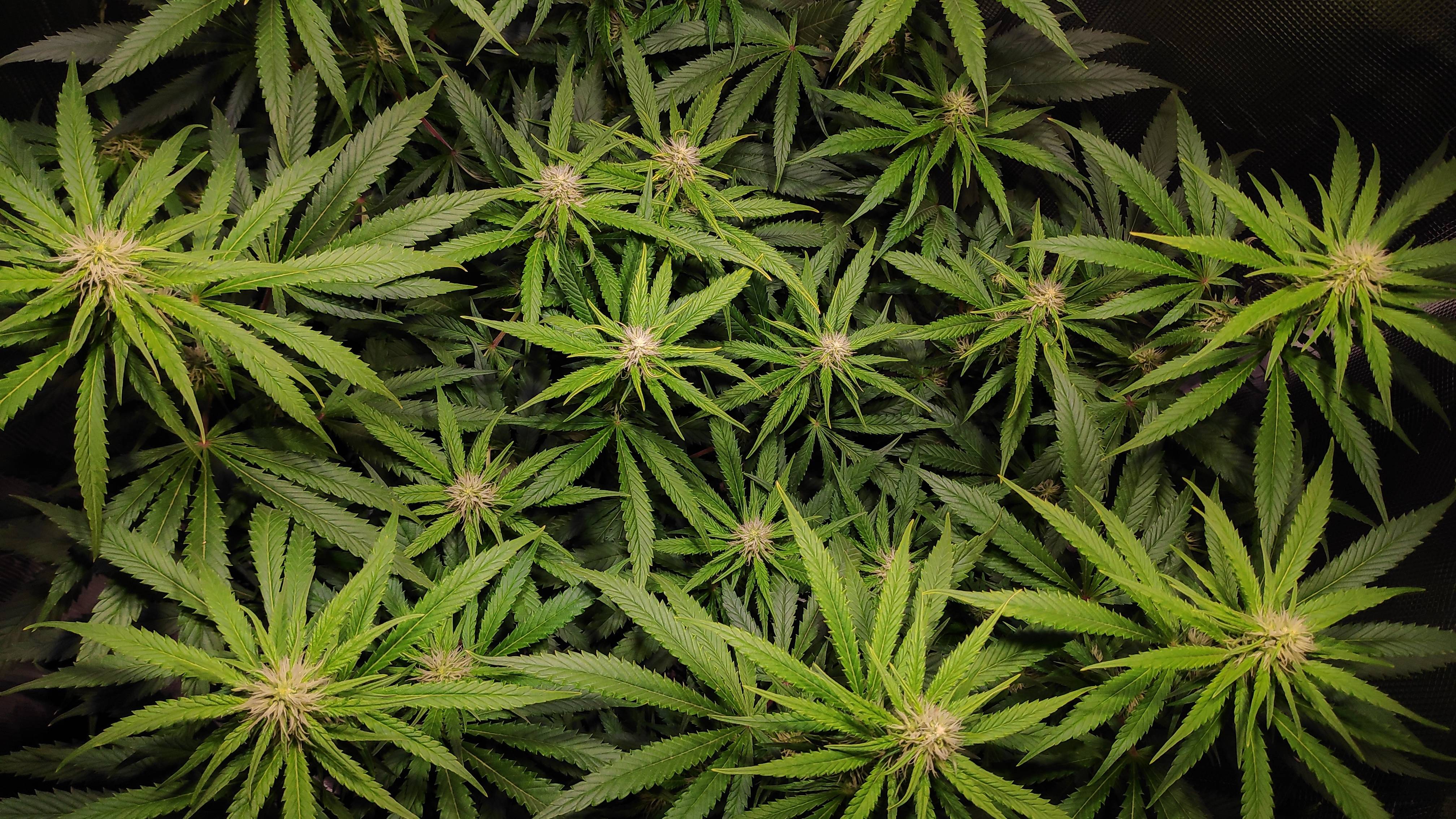

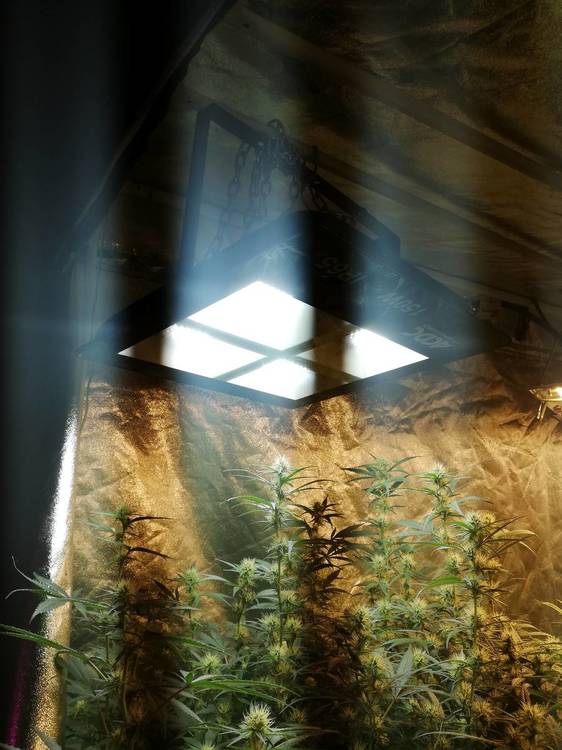
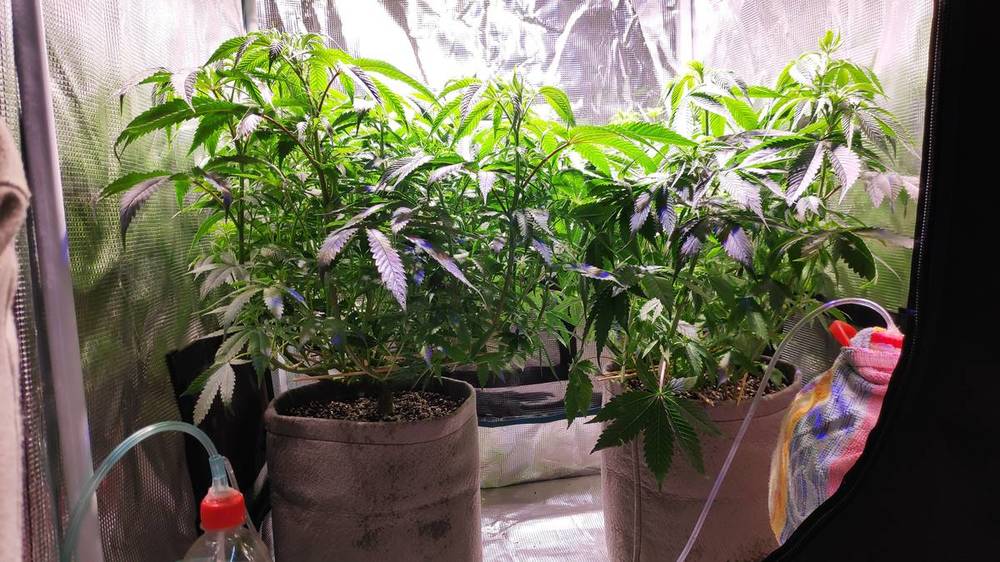
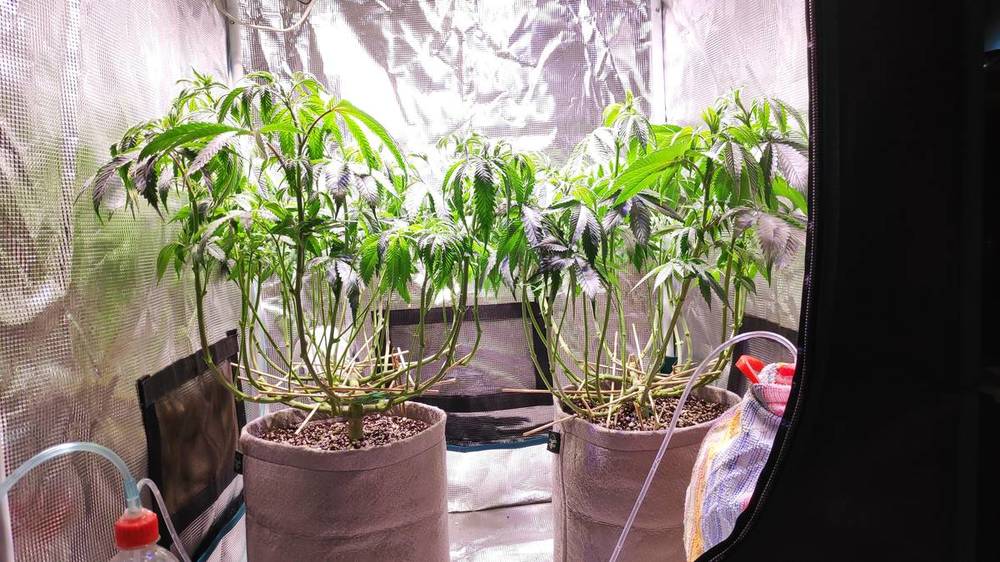
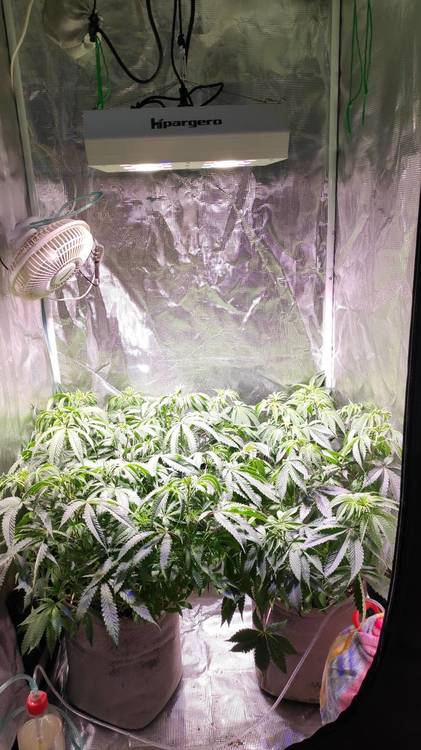
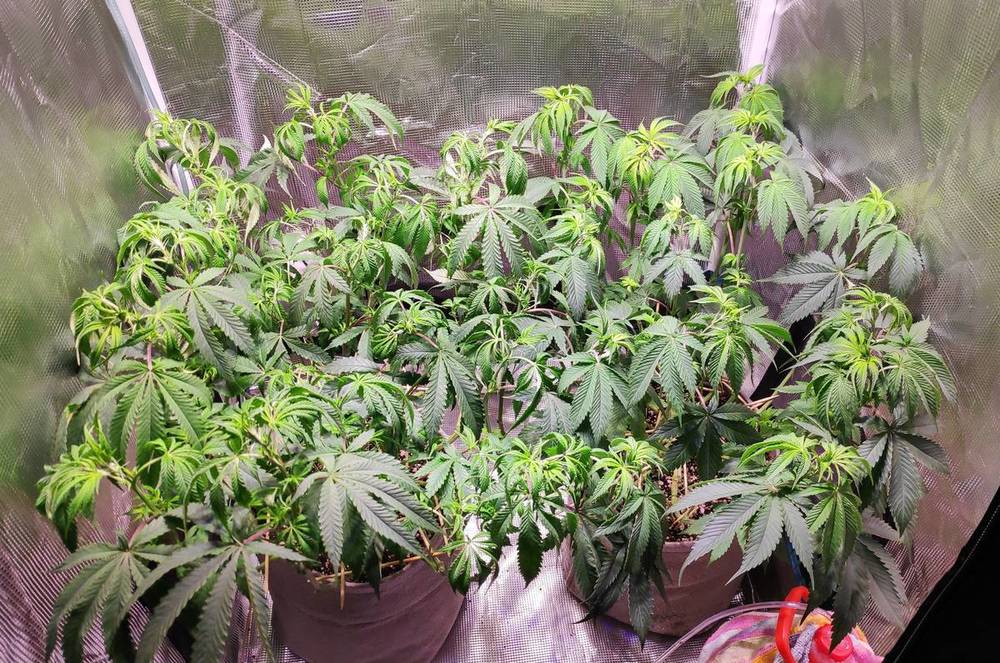
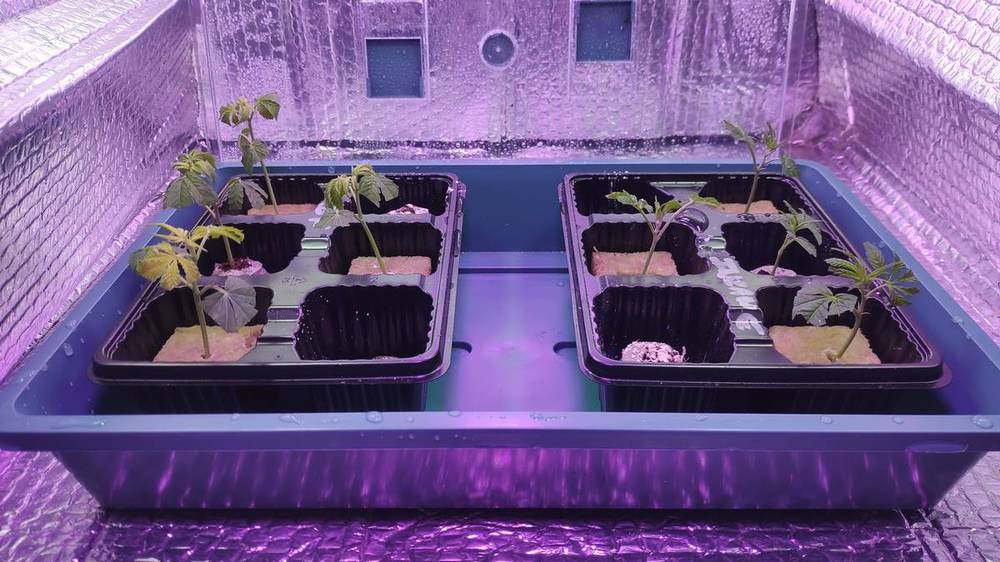
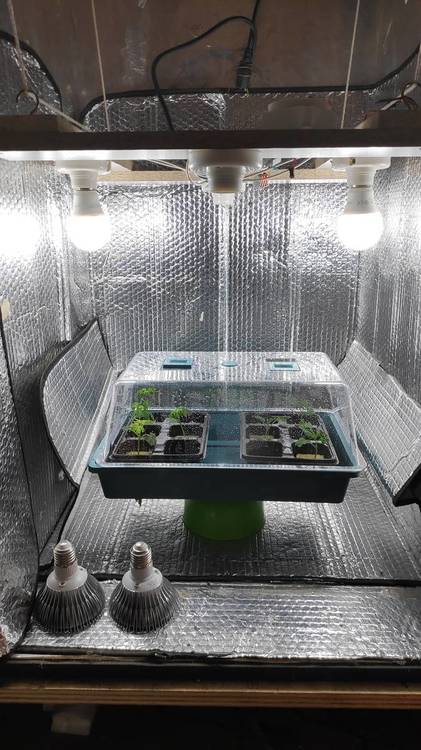
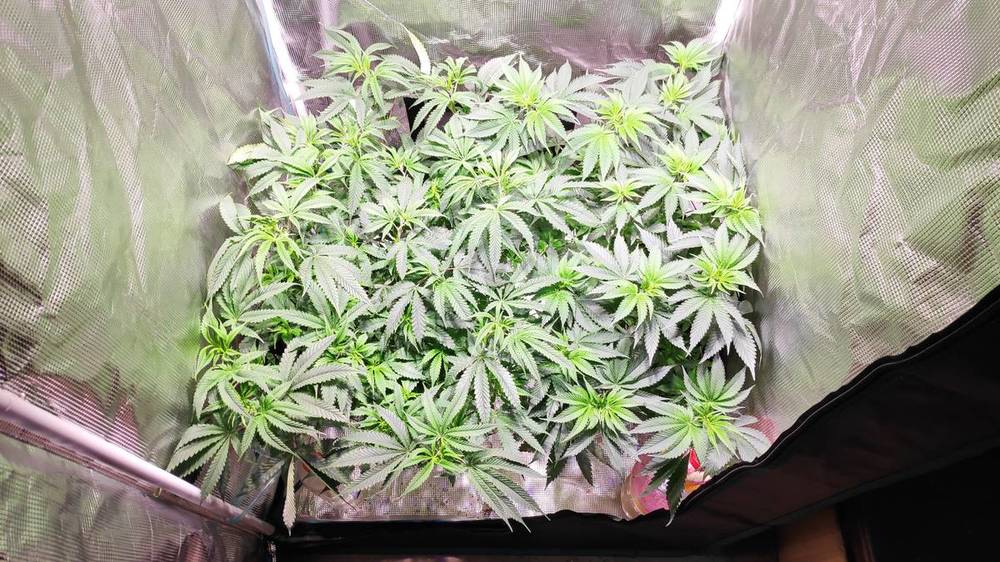
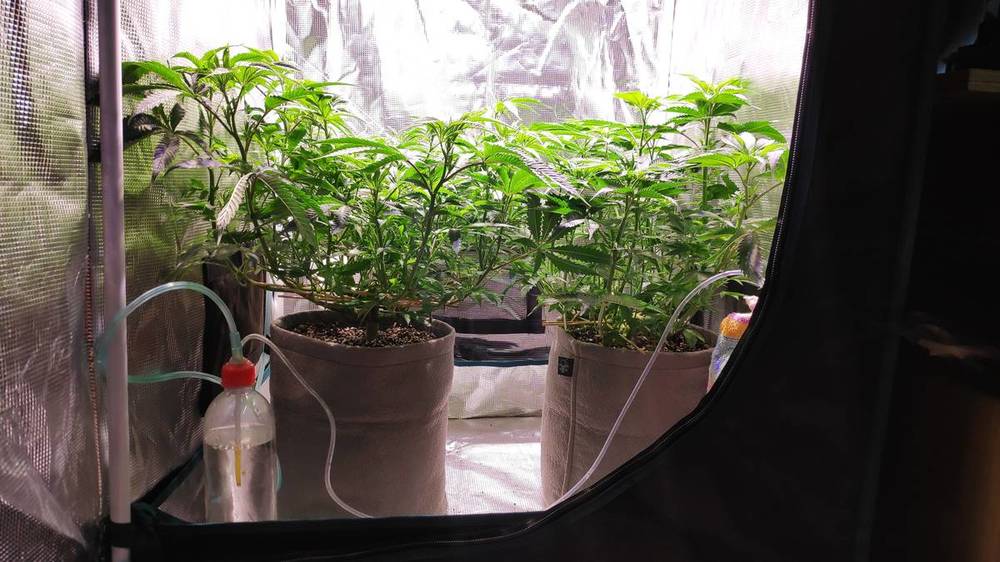
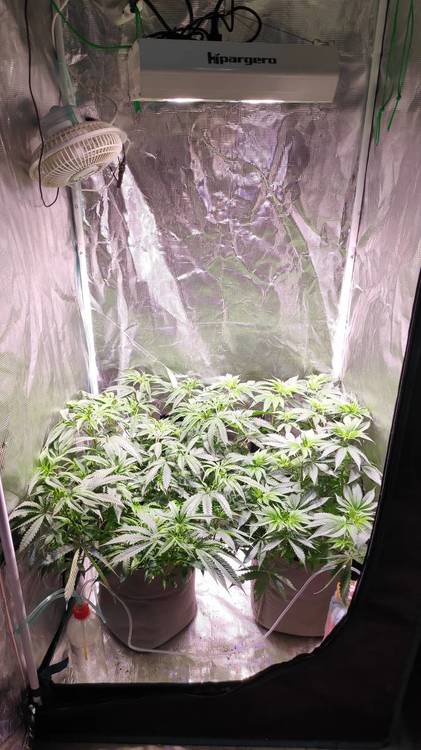
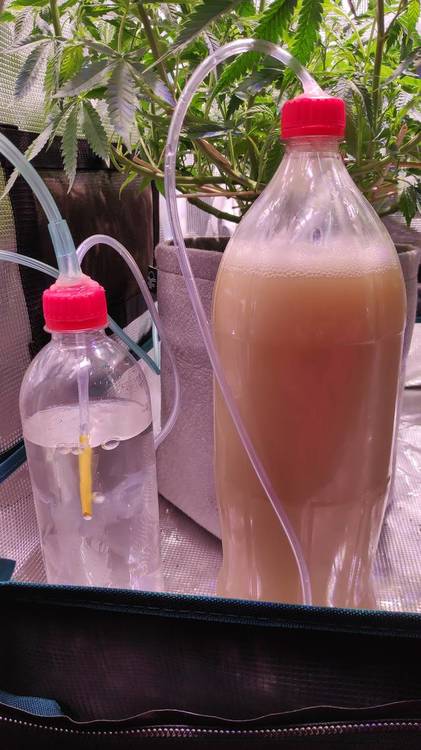
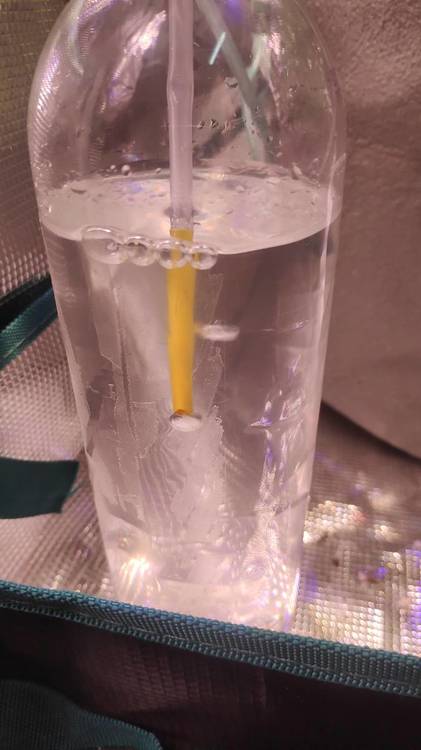
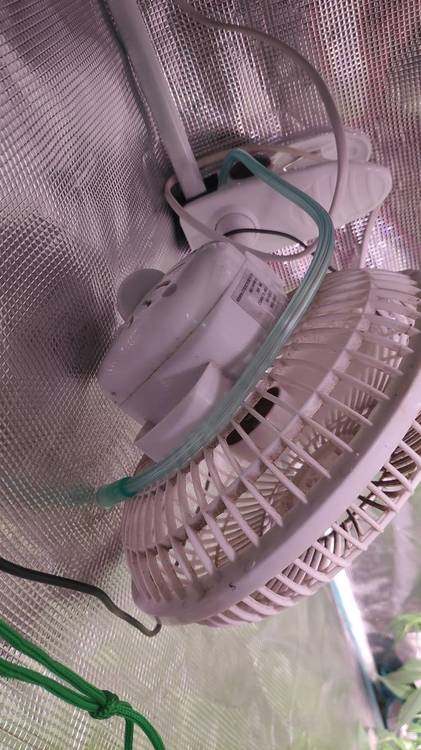


New grower needing help choosing a light
in Starting Your Own Grow
Posted
Which ones did you get?
Sent from my POCOPHONE F1 using Tapatalk